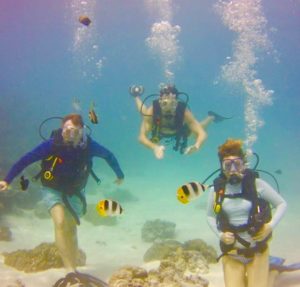Written by Robyn Stacy-Humphries
Wolverine, Spiderman, Wonder Woman, and Deadpool – superheroes most of us love. Why? They have superpowers and escape death by some type of genetic alteration. Humans have always been fascinated with escaping their own mortality.
I should be dead, probably four years ago, but I am alive. Although I do not have a superpower and certainly not movie star good looks, I am a genetically altered human.

My story began ten years ago in 2011 at age 48. I was practicing radiology, at the height of my career, mothering three children, married to a supportive husband, and eating healthy while exercising daily. Twenty-four hours after I felt a dreaded supraclavicular lymph node (mass above my collar bone), I stepped off a CT scanner and reviewed the images on the monitor—I had cancer, probably lymphoma. A few days later after a biopsy, the diagnosis of diffuse large B cell lymphoma,-DLBCL- a very aggressive non-Hodgkin’s lymphoma, was made. The odyssey had begun.
Five years later, after 14 rounds of chemotherapy with 16 different life-saving poisons, four lymph node biopsies, three indwelling ports, septic shock, a broken arm, complete hair loss twice, four spinal taps, three bone marrow biopsies, partial vocal cord paralysis, osteoporosis, and brutal head and neck radiation with secondary hypothyroidism, I stepped off a PET/CT scanner and immediately saw the bright spots of cancerous lymph nodes. I broke down and sobbed. The DLBCL had returned with a vengeance a mere nine months after an autologous bone marrow transplant. A few days later, I was informed that I had no match for an allogeneic bone marrow transplant due to my multiethnic heritage. Statistically, I had six months to live without a suitable therapy.

Being a physician/patient has some advantages. Reading the research literature about lymphoma, I knew that Car-T cell therapy had some promise in phase 1 trials. Specifically, out of 26 patients, 12 had survived a phase one trial and were in remission.
Car-T cell therapy is a process in which T cells( a type of white blood cell) are removed from a patient using apheresis and sent to a specialty lab for modification. In the lab, a viral vector is used to insert a CAR protein onto the surface of the T cell. This protein can vary but for B cell lymphomas or leukemias, is currently a CD-19 protein which is an antigen on all B cells, including the B cell cancer. When the T cells are re-infused into the patient—like a blood transfusion—, these genetically altered T cells search out all the B cells with the CD 19 protein and destroy them. Think of a heat-seeking missile blowing up cancer cells. The CD 19 CAR-T cell therapy results in a mild to moderate immunodeficiency because normal and abnormal B cells are destroyed. However, patients can live with immunodeficiency but cannot live with aggressive lymphoma.
Desperately searching for an open space in a phase 2 clinical trial, we emailed every Car-t lymphoma trial from the www.clinicaltrials.gov website and also emailed primary car-T investigators around the world. Suddenly, a space opened up in a US trial 7 hours away. It was like winning the lottery! I had hope.

My T cells were removed May in 2016. Re-infusion was to occur in July 2016 but due to laboratory and FDA delays, I had a bridging chemotherapy. This was an off-label and successful trial of Ibrutinub, another recent immunotherapy, which put me into clinical remission. Due to trial rules, the medicine was discontinued weeks prior to Car-T infusion and the cancer returned immediately. The rapid progression was disconcerting and surreal with lymph nodes doubling in size every few days.

Finally, on September 14, 2016, I received my tiny bag of 600 million car-T cells via a 5 minutes IV flush. A host of medical personal (pre-Covid) was in the room to observe my genetic transformation. Everyone clapped. Now, we would wait, but not for long. Twenty-four hours after infusion, I had a low-grade fever and my lymph nodes started to melt like ice cubes. Five days later, almost all my lymph nodes were gone as the side effects of cytokine release syndrome (CRS) began. I developed grade 2 CRS, an inflammatory response by the body, with a fever of 104 and very low blood pressure. This subsided in a few days and four weeks after infusion, I returned to work part time—with all of my hair. Three months later, complete remission was confirmed. I had been given a second chance at life.
The JULIET Car-T trial was a success with approximately 35% of patients obtaining a durable, complete remission. The Car-T cell product, Kymriah, was approved by the FDA in 2017 so that others now receive this life-saving therapy. Since then, many other trials have Car-T have shown success with more product approval for blood cancers but also early success in many solid tumors. Currently, cancer therapies are rather barbaric—involving cutting, poisoning, or burning tumors—and normal tissue. Immunotherapy such as Car-T is certainly what we hope for in the future.
Becoming a physician was a life-long dream, and I remain dedicated to the field of radiology. Grateful to be working, I have a special connection to cancer patients and see hundreds of mammography patients every week. With my second chance, I am relishing life including becoming open water dive certified 3 months after Car-T. I dove in Bora Bora, climbed Skellig Michael in Ireland, hiked in Chilean Patagonia, and ran the Cooper River Bridge run three times. Furthermore, I remain committed to giving back by fundraising for cancer charities including the Lymphoma Research Foundation and recently raised 265K for the Leukemia and Lymphoma Foundation as a Woman of the Year candidate in 2020. Overall, I find it ironic that although I have interpreted hundreds of thousands of images and performed hundreds of biopsies, my greatest gift to medicine may not be as a radiologist but as a patient.






